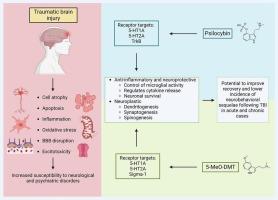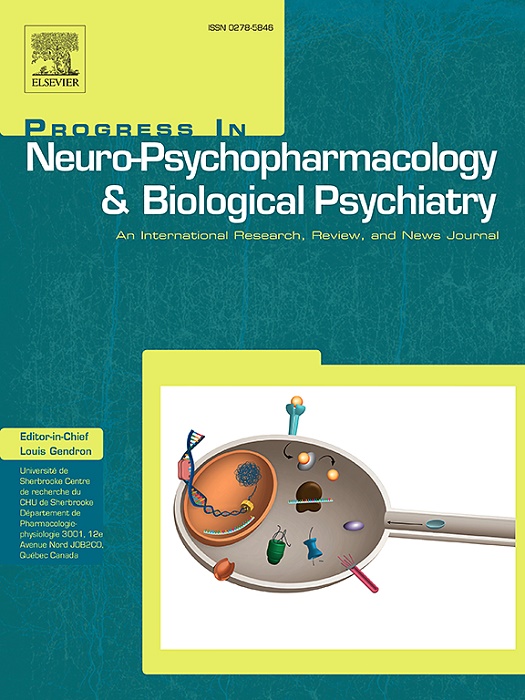探讨裸盖菇素和5-MeO-DMT作为创伤性脑损伤治疗药物的潜力。
IF 3.9
2区 医学
Q1 CLINICAL NEUROLOGY
Progress in Neuro-Psychopharmacology & Biological Psychiatry
Pub Date : 2025-08-30
DOI:10.1016/j.pnpbp.2025.111448
引用次数: 0
摘要
创伤性脑损伤(TBI)是一项重大的全球健康挑战,对其急性和慢性后果的有效治疗有限。TBI的特点是神经炎症、氧化应激、神经可塑性受损、神经传递失衡和细胞死亡,这些因素都有助于神经和精神疾病的发展。新出现的证据表明,5-羟色胺能迷幻药裸盖菇素和5-甲氧基- n, n -二甲基色胺(5-MeO-DMT)可能有望治疗创伤性脑损伤。这些化合物促进神经可塑性,发挥抗炎和神经保护作用,并在治疗与TBI具有共同病理生理特征的精神疾病方面显示出疗效。5-HT1A和5-HT2A受体与它们的作用有关,但裸盖菇素也靶向神经营养TrkB受体,而5-MeO-DMT靶向已知具有神经保护特性的sigma-1受体。本综述整合了目前的临床前和临床研究,强调了裸盖菇素和5-MeO-DMT可能缓解tbi相关损伤的共同和独特的机制途径,如认知和情感功能障碍以及神经炎症。此外,对这些致幻剂的安全性、给药模式和临床挑战进行了严格的审查。通过连接迷幻科学和神经创伤研究的见解,本综述强调了裸盖菇素和5-MeO-DMT作为TBI辅助治疗的创新潜力,为神经康复的新干预措施铺平了道路。本文章由计算机程序翻译,如有差异,请以英文原文为准。

Examining the potential of psilocybin and 5-MeO-DMT as therapeutics for traumatic brain injury
Traumatic brain injury (TBI) is a significant global health challenge, with limited effective treatments for its acute and chronic consequences. TBI is characterized by neuroinflammation, oxidative stress, impaired neuroplasticity, imbalances in neurotransmission, and cell death - factors that contribute to the development of neurological and psychiatric disorders. Emerging evidence suggests that serotonergic psychedelics psilocybin and 5-methoxy-N,N-dimethyltryptamine (5-MeO-DMT) may hold promise as treatments for TBI. These compounds promote neuroplasticity, exert anti-inflammatory and neuroprotective effects, and have shown efficacy in treating psychiatric conditions that share pathophysiological features with TBI. 5-HT1A and 5-HT2A receptors are implicated in their effects, but psilocybin also targets neurotrophic TrkB receptors, whereas 5-MeO-DMT targets sigma-1 receptors, known to have neuroprotective properties. This review integrates current preclinical and clinical research, highlighting both the shared and distinct mechanistic pathways through which psilocybin and 5-MeO-DMT may alleviate TBI-related impairments, such as cognitive and affective dysfunction and neuroinflammation. Additionally, the safety profiles, dosing paradigms, and clinical challenges of these psychedelics are critically examined. By bridging insights from psychedelic science and neurotrauma research, this review underscores the innovative potential of psilocybin and 5-MeO-DMT as adjunctive treatments for TBI, paving the way for novel interventions in neurorehabilitation.
求助全文
通过发布文献求助,成功后即可免费获取论文全文。
去求助
来源期刊
CiteScore
12.00
自引率
1.80%
发文量
153
审稿时长
56 days
期刊介绍:
Progress in Neuro-Psychopharmacology & Biological Psychiatry is an international and multidisciplinary journal which aims to ensure the rapid publication of authoritative reviews and research papers dealing with experimental and clinical aspects of neuro-psychopharmacology and biological psychiatry. Issues of the journal are regularly devoted wholly in or in part to a topical subject.
Progress in Neuro-Psychopharmacology & Biological Psychiatry does not publish work on the actions of biological extracts unless the pharmacological active molecular substrate and/or specific receptor binding properties of the extract compounds are elucidated.

 求助内容:
求助内容: 应助结果提醒方式:
应助结果提醒方式:


